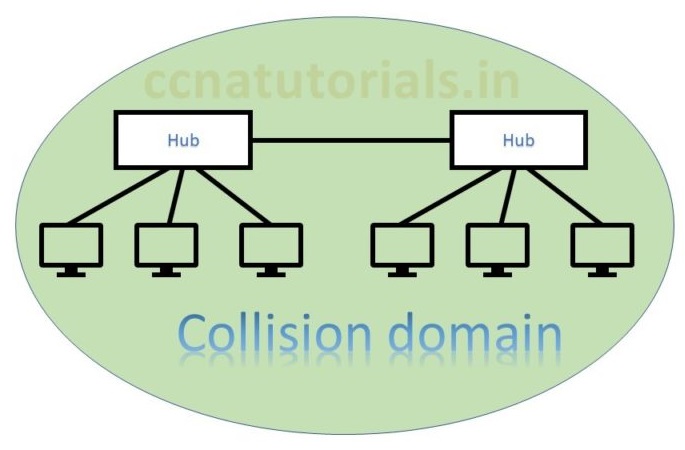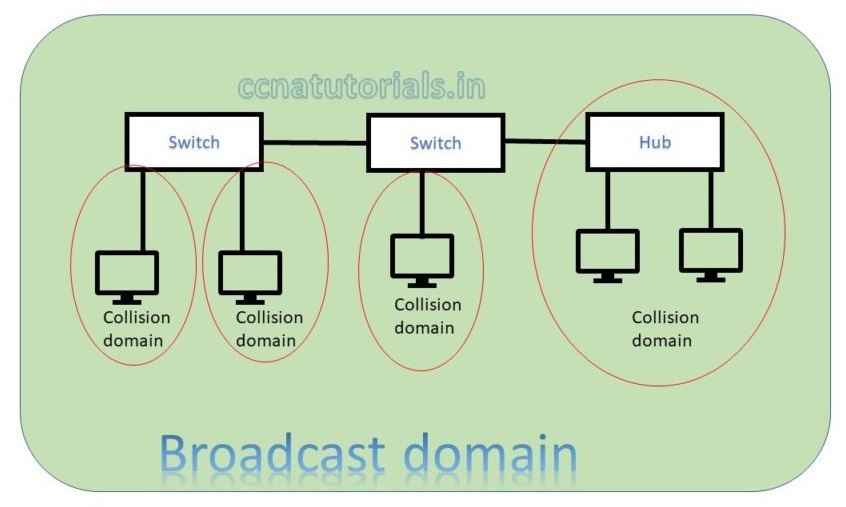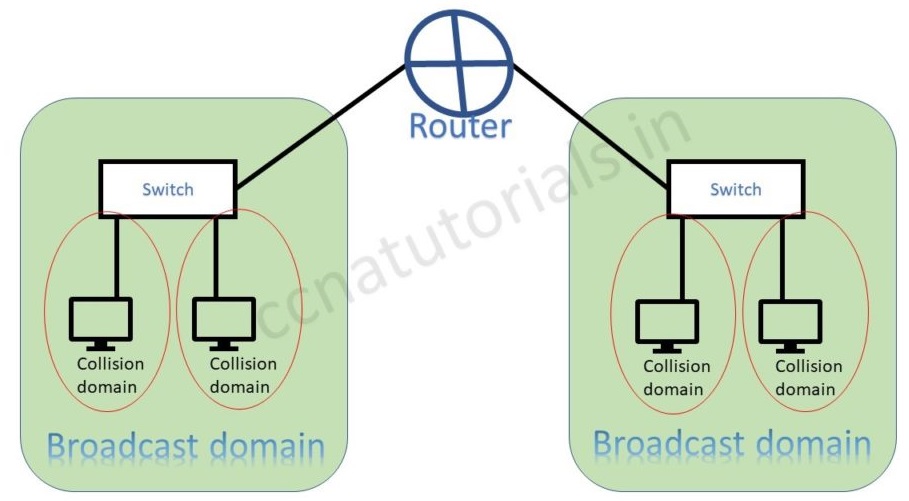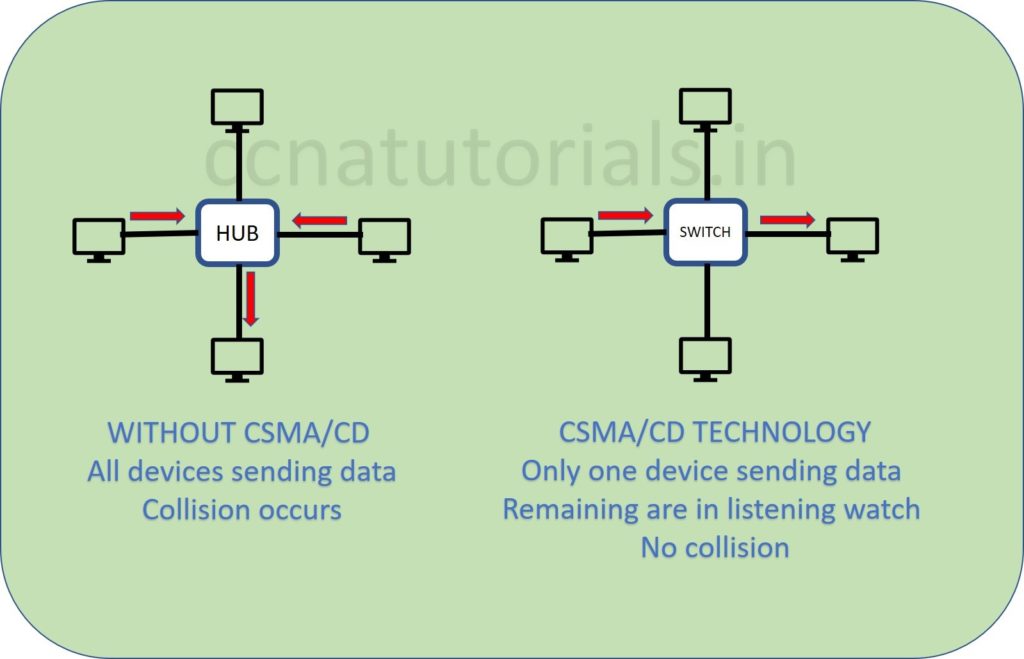In this article I describe the collision domain and broadcast domain in Networking for CCNA Exam. collision domain and broadcast domain in networking is necessary learning for the networking. Ethernet provides connectivity to the networking devices in a network. An Ethernet provides physical connectivity for data transfer between the devices in a network. There are various standards of Ethernet available according to the speed and reliability.
Ethernet works on Data link and physical layer of OSI reference model. collision domain and broadcast domain in networking is related to access the media from a device. The Ethernet provides connectivity between nodes and different networking devices. Ethernet connector also known as RJ45 connector. Implementation and maintains of Ethernet is very easy. Ethernet port provides speed up to gigabits per second. Ethernet is responsible for formatting and transmission of data in a predefined format. Similarly, at the receiver end the received data reformatted in a predefined format.
Generally we use the switch and routers for networking devices. Some time other terms like hub and bridge also come into picture when we study in deep about networking. What is the main difference there between a switch and hub? We know both devices works to connect the devices in the network. A hub can provide the connectivity to the endpoint devices similar to the switch. What is the technical term which differentiate them both? The terms are collision domain and broadcast domain in networking.
In general way for a ordinary person there is no any difference between the HUB and a Switch. If you see technically there is a very big difference between hub and switch. We can differentiate hub and switch on the basis of collision domain and broadcast domain in networking. For a little hint about the collision domain and broadcast domain in networking you can assume that hub works on physical layer while a switch works on data link layer. To know in deep about the function of these layers you can see the OSI reference model of 7 layers here.
Definition of collision domain and broadcast domain in networking
Collision domain refer in a network where multiple devices using same medium for data transmission and reception at a time. I mean in a network when multiple devices transmit the data same time the collision occurs. For example in a HUB network there is no any mechanism which allow only a single device to transmit the data in the network. So all the devices connected with a HUB comes in a single collision domain. The basic need of a network is that only a device should transmit the data at a time. Rest all the devices should remain in listening mode. To overcome the problems with the collision domain layer 2 switches come into use and CSMA/CD technique used which reduced the collision domain effect in the network. All the ports of a HUB or Bridge belongs to a single collision domain.
Broadcast domain in networking refers to a situation when all devices come in a single broadcast at the data link layer. We can say the broadcast domain related to data link layer while the collision domain relates to physical layer in networking. A broadcast domain lies within a single LAN segment. In other words we can say the devices connected to the same switch belongs to a single broadcast domain in networking. Each port of a switch have its own unique collision domain. All ports belongs to a common VLAN of a switch belongs to a common broadcast domain.
We can say by default all ports of a layer 2 switch remains in a single broadcast domain. When we breaks the switchports in to different VLAN actually we are breaking the broadcast domains. So each VLAN in a switch have a separate broadcast domain. Before going to deep in the collision domain and broadcast domain in networking we need to understood some other related terms to Ethernet basic concept in networking.
Working of Ethernet: collision domain and broadcast domain in Networking
Ethernet belongs to IEEE standard IEEE 802.3 family. collision domain and broadcast domain in networking, Ethernet working depends on both physical and data link layer. The Ethernet send and receive the bits and frame in a network. Physical layer defines the bits streaming and data link layer defines the frame streaming. Ethernet is responsible for VLAN tagging, QOS, error correction and identify the transmission problems. An Ethernet do work metallic conductor cables. Ethernet cable may be co-axial, twisted pair or CAT-6 cables.
collision domain and broadcast domain in networking depends on Ethernet protocols. collision domain and broadcast domain in networking define by the connectivity media like hub, switch etc. The collision domain and broadcast domain defined at different layers of OSI model.
Collision Domain in networking
Collision domain term related to hub or physical layer devices. Hub use a common media to send and receive the data. Hub works as a shared media in an Ethernet network. Data flow on a single media and collapse several times. This is the reason of collision and the devices belongs to this network are lie in a common collision domain. Bus topology is the best example of collision data. Bus topology and Ethernet hub are half duplex. These devices can send or receive data at the same time. To overcome collision in a network CSMA/CD technique used. Later we will discuss about these Ethernet basic concept in networking.

In above picture two hubs are connected with each other. Both hubs belongs to a common collision domain. Hub works on physical layer transmit the data to all connected devices. This is why collision occurs. In this scenario data lost generally and the sender must resend the data. Data collision responsible for poor network performance. Layer 2 switch breaks the collision domain in a network. Each switchport of the switch belongs to its own collision domain.

In above picture two switch creates a network. Both switch and connected device are in a single broadcast domain. Each port of switch itself creates a separate collision domain. There are four collision domains. All devices connected with a Hub remains in a collision domain.
According to both above pictures we can say a switch breaks collision domain. Switch do not break a broadcast domain, so all ports of a switch belongs to a broadcast domain. By using switch in place of hub the collision domains break and performance of network improved.
In above example you learn about collision domain. How collision domain occurs and how to overcome the collision of data in a network.
Broadcast Domain in networking
Broadcast domain defines the boundary of data broadcasting in a network. All ports of a switch belong to a single broadcast domain. Each port of a switch breaks the collision domain and create its own collision domain. Each port of a router breaks the broadcast domain. The port of a router have its own broadcast domain. Further switch uses to break the collision domain. In a broadcast domain device communicate via Data Link Layer. Creation of VLAN in a switch will break the broadcast domain virtually. Creating the VLANs make the network fast and redundant. CSMA/CD technique used in layer 2 switches. Which allow only single device to transmit the data at a single time.

The above picture shows the difference of broadcast and collision domain. Switch breaks collision domain and router breaks the broadcast domain in a network.
Switch can break the broadcast domain logically via creating VLAN. A router creates broadcast domain boundaries. The size of broadcast domain is responsible for performance of network. It is good to keep the broadcast and collision domain as small as possible. This practice will improve the network performance also data flow speed. I hope you understood the collision domain and broadcast domain in networking. Now lets see some basics of the CSMA/CD in networking.
CSMA/CD for Colllision and Broadcast domain in networking
CSMA/CD acronym for Carrier Sense Multiple Access with Collision Detection. The CSMA/CD protocol overcome the collision problem occurs in a network segment. Which helps devices to share the bandwidth in a network segment. CSMA/CD control the data flow in a network segment. This protocol prevents multiple devices to transmit data simultaneously. This prevention improves the network performance.
In below picture CSMA/CD protocol working defines. The hub network shows all devices transmitting data simultaneously. This will make poor network performance and data collision occurs. In switch network diagram only one device transmitting the data. Remaining all devices are receiving and waiting for their turn to transmit. CSMA/CD improve the network efficiency by reducing the collision domain and broadcast domain in networking.

Working of CSMA/CD protocol for Ethernet Basic concept in networking
In above diagram see the switch network. Suppose a computer need to transmit data for another one. Sender computer sense the signal in the transmission media. In case there is any signal found transmitting then sending computer will wait to finish it. This protocol works for all devices. So, it become easy to control the traffic in a network. When a device transmitting the data all the other devices remains in listening mode. So this feature of CSMA/CD avoid the collision domain and broadcast domain in networking.
Half- and Full-Duplex related to collision domain and broadcast domain in networking
IEEE 802.3 standard identify the half duplex Ethernet. In half duplex Ethernet the data flow one side at a time. Collision domain occurs in a Half Duplex network. Suppose two devices are connected with half duplex Ethernet. At one time only one device can send the data. Half duplex Ethernet uses the CSMA/CD protocol. Collision occurs in half duplex Ethernet network. A hub relates to a switch works like a half-duplex Ethernet network. Data flow speed is very low in a half-duplex network due to collision. Half-duplex Ethernet network uses one pair wire for flow of data in the network.
Full-duplex Ethernet works on two pair wire. Full-duplex Ethernet uses point to point connections between sending and receiving device. Full duplex Ethernet network works like a telephone communication. Simultaneously data send and receive in a full-duplex network. Data flow speed is fast in a full-duplex Ethernet network than half-duplex Ethernet network. Each device has its own collision domain in full-duplex Ethernet network. CSMA/CD protocols are used in full-duplex Ethernet network. Full-duplex Ethernet are switch to switch, host to host, router to router, switch to host, switch to router etc.
In this article I describe the collision domain and broadcast domain in networking alongwith CSMA/CD technology. I hope you found this article helpful for CCNA exam. For any query or suggestion you may drop a comment below or contact us. Your suggestions are always welcome by us.




whoah this blog is great i really like studying your posts. Stay up the good work! You already know, lots of persons are searching around for this info, you could help them greatly.
Hello,
Aren’t there 5 collision domains instead of 4? Wouldn’t the port coming from the first switch going into the second one be considered another collision domain?
Tiffany